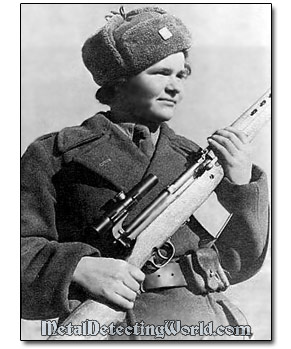Part I - WW2 Relic Hunting at the Swedish Tavern Site, page 31
Recovering a Fragment of WWII Russian Tokarev SVT-40 Rifle
In this region of Russia, which saw lots of WW2 military action, the spots with high concentration of war junk can be anywhere. One moves 30 meters in any direction and unexpectedly ends up at the spot with lots of WW2 junk - the most common situation which I had right now. My next WW2 relic find was a rusty fragment of some firearm. For the sake of this story, I had to figure out what WW2 gun it exactly belonged to.
Rusty Part of WW2 Gun Unearthed

It took me a while to research various weapons of the period, and finally I determined that this was a part of the Soviet Tokarev SVT-40 Rifle.

Tokarev SVT-40 Rifle - Brief Historical Facts:
The SVT-40 (Samozaryadnaya Vintovka Tokareva - Tokarev Self-loading Rifle, Model of 1940) is a gas-operated weapon with a short-stroke, spring-loaded piston above the barrel and a tilting bolt. The receiver is open-top, which enables reloading of the magazine using five-round Mosin-Nagant stripper clips. SVT-40 is an improved version of SVT-38 which saw its combat debut in the 1939-1940 Winter War with Finland. SVT-40 was more refined and lighter and designed to simplify its manufacture.

By the time the German Army invaded the U.S.S.R. in June 1941, the SVT-40 was already in widespread use by the Red Army. The beginning of the war was disastrous for the Soviet Union, and hundreds of thousands of SVT-40s were lost to the Germans. Because the Germans were short of self-loading rifles themselves, the SVT (designated as SIG.259(r) by the Wehrmacht) rifles were widely used by German soldiers. The Germans issued their own operating manual for the SVT-40.
The SVT-40 was in general no worse than American M1 Garand (and had some advantages over it, especially in the reloading procedures), and obviously better than earlier German Gew.41 semi-automatic rifles. SVT-40 rifle was highly regarded by the Finns and Germans and it was a very sought-after war trophy, re-issued to both German and Finnish troops. On the other hand, it was often considered unreliable and over-complicated by the Soviet infantry (when comparing with old Mosin-Nagant M1891/30 bolt-action rifles), but it was more to the poor training and maintenance, than to the rifle itself.
Russian submachine guns like the PPSh-41 - simple, cheap, and effective weapons to supplement infantry firepower, became more popular among Soviet soldiers that had only rudimentary training. Only better trained and educated Soviet Sea Infantry (the Red Army's elite troops) used the SVT-40 with great deal of success.
After World War II, new weapons like the SKS and the AK-47 made the SVT obsolete, and the weapon was generally out of service by 1955. Only a few SVT's were exported to Soviet allies and clients. Reportedly, some SVT's were used by Cuban revolutionaries in the 1950s. The Finnish Army retired the SVT in 1958, and about 7,500 rifles were sold to the US civilian market through firearm importer Interarms.
Currently the SVT is highly sought by the collectors and historical enthusiasts. The rifle's popularity is due to a combination of the inexpensive nature of its 7.62x54mmR ammunition, favorable aesthetics, historical significance, and pleasant shooting characteristics.